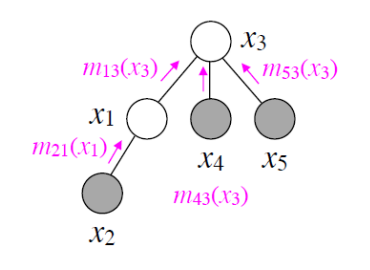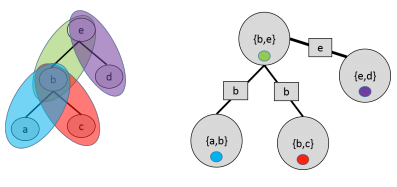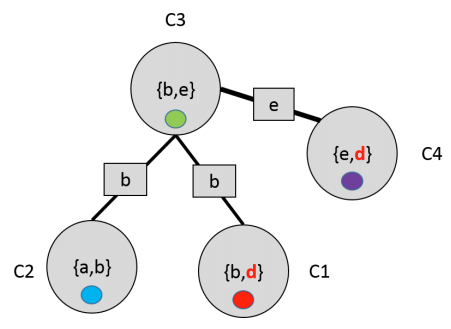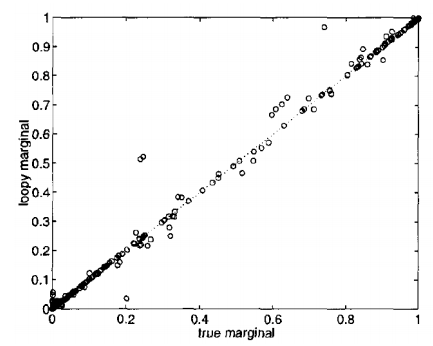Junction tree algorithm
We have seen how the variable elimination (VE) algorithm can answer marginal queries of the form for both directed and undirected networks.
However, this algorithm still has an important shortcoming: if we want to ask the model for another query, e.g. , we need to restart the algorithm from scratch. This is very wasteful and computationally burdensome.
Fortunately, it turns out that this problem is also easily avoidable. When computing marginals, VE produces many intermediate factors as a side-product of the main computation; these factors turn out to be the same as the ones that we need to answer other marginal queries. By caching them after a first run of VE, we can easily answer new marginal queries at essentially no additional cost.
The end result of this chapter will be a new technique called the Junction Tree (JT) algorithm; this algorithm will first execute two runs of the VE algorithm to initialize a particular data structure holding a set of pre-computed factors. Once the structure is initialize, it will be used to answer marginal queries in time.
We will introduce two variants of this algorithm: belief propagation, and then the full junction tree method. The first one will apply to tree-structured graphs, while the other will be applicable to general networks.
Belief propagation
Variable elimination as message passing
First, consider what happens if we run the VE algorithm on a tree in order to compute a marginal . We can easily find an optimal ordering for this problem by rooting the tree at and iterating through the nodes in post-orderA postorder traversal of a rooted tree is one that starts from the leaves and goes up the tree such that a node if always visited after all of its children. The root is visited last. .
This ordering is optimal because the largest clique that formed during VE will be of size 2. At each step, we will eliminate ; this will involve computing the factor , where is the parent of in the tree. At a later step, will be eliminated, and will be passed up the tree to the parent of in order to be multiplied by the factor before being marginalized out. We can visualize this transfer of information using arrows on a tree.

Message passing order when using VE to compute on a small tree.
In a sense, when is marginalized out, it receives all the signal from variables underneath it from the tree. Because of the tree structure (variables affect each other only through their direct neighbors), this signal can be completely summarized in a factor . Thus, it makes sense to think of the as a message that sends to to summarize all it knows about its children variables.
At the end of the VE run, receives messages from all of its immediate children, marginalizes them out, and we obtain the final marginal.
Now suppose that after computing , we wanted to compute as well. We would again run VE elimination with as the root. We would again wait until receives all of messages from its children. The key insight here is that the messages will receives from will be the same as when was the rootAnother reason why this is true is because there is only a single path connecting two nodes in the tree. . Thus, if we store the intermediary messages of the VE algorithm, we can quickly recompute other marginals as well.
A message-passing algorithm
A key question here is how exactly do we compute all the message we need. Notice for example, that the messages to from the side of will need to be recomputed.
The answer is very simple: a node sends a message to a neighbor whenever it has received messages from all nodes besides . It’s a fun exercise to the reader to show that there will always be a node with a message to send, unless all the messages have been sent out. This will happen after precisely steps, since each edge can receive messages only twice: once from , and once more in the opposite direction.
Finally, this algorithm will be correct because our messages are defined as the intermediate factors in the VE algorithm
Sum-product message passing
We are now ready to formally define the belief propagation algorithm. This algorithm will have two variants, the first of which is called sum-product message passing. This algorithm is defined as follows: while there is a node ready to transmit to , send the message
Again, observe that this message is precisely the factor that would transmit to during a round of variable elimination with the goal of computing .
Because of this observation, after we have computed all messages, we may answer any marginal query over in constant time using the equation
Max-product message passing
So far, we have said very little about the second type of inference we are interested to perform, which are MAP queries
The framework we have introduced for marginal queries now lets us easily perform MAP queries as well. The key observation to make, is that we can decompose the problem of MAP inference in exactly the same way as we decomposed the marginal inference problem by replacing sums with maxes.
For example, we may compute the partition function of a chain MRF as follows:
To compute the mode of , we simply replace sums with maxes, i.e.
The key property that makes this work is the distributivity of both the sum and the max operator over products. Since both problems are essentially equivalent (after swapping the corresponding operators), we may reuse all of the machinery developed for marginal inference and apply it directly to MAP inference.
There is a small caveat in that we often want not just the mode of a distribution, but also its most probable assignment. This problem can be easily solved by keeping back-pointers during the optimization procedure. For instance, in the above example, we would keep a backpointer to the best assignment to given each assignment to , a pointer to the best assignment to given each assignment to , and so on.
Junction tree algorithm
So far, our discussion assumed that the graph is a tree. What if that is not the case? Inference in that case will not be tractable; however, we may try to massage the graph to its most tree-like form, and then run message passing on this graph.
At a high-level the junction tree algorithm will try to achieve this by partitioning the graph into clusters of variables; internally, the variables within clusters could be highly coupled; however, interactions among clusters will have a tree structure, i.e. a cluster will be only directly influenced by its neighbors in the tree. This will lead to tractable global solutions if some local (cluster-level) problems can be solved exactly.
An illustrative example
Before we define the full algorithm, let us first start with an example, like we did for the variable elimination algorithm.
Suppose that we are performing marginal inference and that we are given an MRF of the form
Crucially, we will assume that the cliques have a form of path structure, meaning that we can find an ordering with the property that if and for some variable then for all on the path between and . We refer to this assumption as the running intersection (RIP) property.

Suppose that we are interested in computing the marginal probability in the above example. Given our assumptions, we may again use a form of variable elimination to ``push in” certain variables deeper into the product of cluster potentials:
We first sum over , which creates a factor . Then, gets eliminated, and so on. At each step, each cluster marginalizes out the variables that are not in the scope of its neighbor. This marginalization can also be interpreted as computing a message over the variables it shares with the neighbor.
The running intersection property is what enables us to push sums in all the way to the last factor. We may eliminate because we know that only the last cluster will carry this variable: since it is not present in the neighboring cluster, it cannot be anywhere else in the graph without violating the RIP.
Junction trees
The core idea of the junction tree algorithm is to turn a graph into a tree of clusters that are amenable to the variable elimination algorithm like the above MRF. Then we simply perform message-passing on this tree.
Suppose we have an undirected graphical model (if the model is directed, we consider its moralized graph). A junction tree over is a tree whose nodes are associated with subsets of the graph vertices (i.e. sets of variables); the junction tree must satisfy the following properties:
- Family preservation: For each factor , there is a cluster such that .
- Running intersection: For every pair of clusters , every cluster on the path between contains .
Here is an example of an MRF with graph and junction tree . MRF potentials are denoted using different colors; circles indicates nodes of the junction trees; rectangular nodes represent sepsets, which are sets of variables shared by neighboring clusters.


A junction tree defined over a tree graph. Clusters correspond to edges.

Example of an invalid junction tree that does not satisfy the running intersection property.
Note that we may always find a trivial junction tree with one node containing all the variables in the original graph. However, such trees are useless because they will not result in efficient marginalization algorithms.
Optimal trees are one that make the clusters are small and modular as possible; unfortunately, it is again NP-hard to find the optimal tree. We will see below some practical ways in which we can find good junction trees
A special case when we can find the optimal junction tree is when itself is a tree. In that case, we may define a cluster for each edge in the tree. It is not hard to check that the result satisfies the above definition.
The junction tree algorithm
Let us now define the junction tree algorithm, and then explain why it works. At a high-level, this algorithm implements a form of message passing on the junction tree, which will be equivalent to variable elimination for the same reasons that BP was equivalent to VE.
More precisely, let us define the potential of each cluster as the product of all the factors in that have been assigned to . By the family preservation property, this is well-defined, and we may assume that our distribution is in the form
Then, at each step of the algorithm, we choose a pair of adjacent clusters in and compute a message whose scope is the sepset between the two clusters:
We choose only if has received messages from all of its neighbors except . Just as in belief propagation, this procedure will terminate in exactly steps. After it terminates, we will define the belief of each cluster based on all the messages that it receives
These updates are often referred to as Shafer-Shenoy. After all the messages have been passed, beliefs will be proportional to the marginal probabilities over their scopes, i.e. . We may answer queries of the form for by marginalizing out the variable in its beliefReaders familiar with combinatorial optimization will recognize this as a special case of dynamic programming on a tree decomposition of a graph with bounded treewidth.
To get the actual probability, we compute the partition function by e.g. summing all the beliefs in a cluster and dividing by .
Note that this algorithm makes it obvious why we want small clusters: the running time will be exponential in the size of the largest cluster (if only because we may need to marginalize out variables from the cluster, which often must be done using brute force). This is why a junction tree of a single node containing all the variables is not useful: it amounts to performing full brute-force marginalization.
Variable elimination over a junction tree
Why does this method work? First, let us convince ourselves that running variable elimination with a certain ordering is equivalent to performing message passing on the junction tree; then, we will see that the junction tree algorithm is just a way of precomputing these messages and using them to answer queries.
Suppose we are performing variable elimination to compute for some variable , where . Let be a cluster containing ; we will perform VE with the ordering given by the structure of the tree rooted at . In the example below, say that we choose to eliminate the variable, and we set as the root cluster.

First, we pick a set of variables in a leaf of that does not appear in the sepset between and its parent (if there is no such variable, we may multiply and into a new factor with a scope not larger than that of the initial factors). In our example, we may pick the variable in the factor .
Then we marginalize out to obtain a factor . We multiply with to obtain a new factor . Doing so, we have effectively eliminated the factor and the unique variables it contained. In the running example, we may sum our and the resulting factor over may be folded into .
Note that the messages computed in this case are exactly the same as those of JT. In particular, will be ready to send its message, it will have been multiplied by from all neighbors except its parent, which is exactly how JT sends its message.
Repeating this procedure eventually produces a single factor , which is our final belief. Since VE implements the messages of the JT algorithm, will correspond to the JT belief. Assuming we have convinced ourselves in the previous section that VE works, we know that this belief will be valid.
Formally, we may prove correctness of the JT algorithm through an induction argument on the number of factors ; we will leave this as an exercise to the reader. The key property that makes this argument possible is the RIP; it assures us that it’s safe to eliminate a variable from a leaf cluster that is not found in that cluster’s sepset; by the RIP, it cannot occur anywhere except that one cluster.
The important thing to note is that if we now set to be the root of the tree (e.g. if we set to be the root), the message it will receive from (or from in our example) will not change. Hence, the caching approach we used for the belief propagation algorithm extends immediately to junction trees; the algorithm we formally defined above implements this caching.
Finding a good junction tree
The last topic that we need to address is the question of constructing good junction trees.
- By hand: Typically, our models will have a very regular structure, for which there will be an obvious solution. For example, very often our model is a grid, in which case clusters will be associated with pairs of adjacent rows (or columns) in the grid.
- Using variable elimination: One can show that running the VE elimination algorithm implicitly generates a junction tree over the variables. Thus it is possible to use the heuristics we previously discuss to define this ordering.
Loopy belief propagation
As we have seen, the junction tree algorithm has a running time that is potentially exponential in the size of the largest cluster (since we need to marginalize all the cluster’s variables). For many graphs, it will be difficult to find a good junction tree, applying the algorithm will not be possible. In other cases, we may not need the exact solution that the junction tree algorithm provides; we may be satisfied with a quick approximate solution instead.
Loopy belief propagation (LBP) is another technique for performing inference on complex (non-tree structure) graphs. Unlike the junction tree algorithm, which attempted to efficiently find the exact solution, LBP will form our first example of an approximate inference algorithm.
Definition for pairwise models
Suppose that we a given an MRF with pairwise potentialsArbitrary potentials can be handled using an algorithm called LBP on factor graphs. We will include this material at some point in the future . The main idea of LBP is to disregard loops in the graph and perform message passing anyway. In other words, given an ordering on the edges, at each time we iterate over a pair of adjacent variables in that order and simply perform the update
We keep performing these updates for a fixed number of steps or until convergence (the messages don’t change). Messages are typically initialized uniformly.
Properties
This heuristic approach often works surprisingly well in practice.

Marginals obtained via LBP compared to true marginals obtained from the JT algorithm on an intensive care monitoring task. Results are close to the diagonal, hence very similar.
In general, however, it may not converges and its analysis is still an area of active research. We know for example that it provably converges on trees and on graphs with at most one cycle. If the method does converge, its beliefs may not necessarily equal the true marginals, although very often in practice they will be close.
We will return to this algorithm later in the course and try to explain it as a special case of variational inference algorithms.